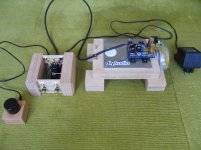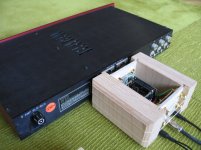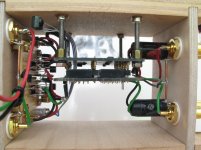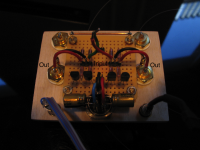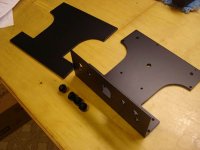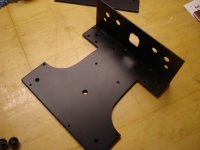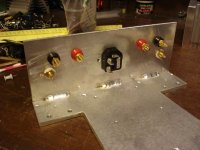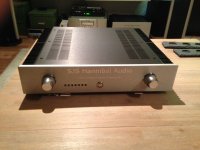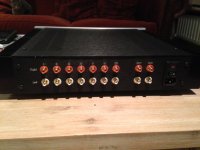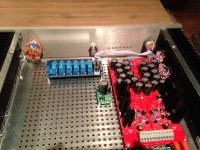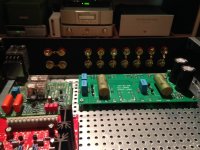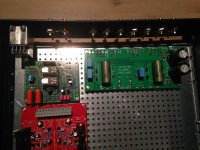All,
Re: Some elbow grease and bastard files later, and I was ready to put the box together.
Nice construction effort. Well done.... However, it's never nice to call your metal files bad names!
As for anodizing. That works well for really thin finishes on heatsinks, but [decorative] anodizing is not necessarily scratch resistant, if that's your final goal. As an alternative, consider powder coating--thicker, almost bulletproof (but not the best for head conduction). Try to Google under "metal finishing", "metal finishers", plating, powder coating for your local area. I recall there being a lot of such shops in the east Bay area, and the industrial South San Francisco area.
I use a 40% matte finish black powdercoat on my amps. If you want, look under my threads in the Pass Amps and/or Chipamp forums to check out my chassis. Prices are reasonable, and the results are professional.
All,
Attached are my ACA pics. I hadn't thought abut building an ACA, I'm in the middle of a J2 clone and I have SIT parts sitting on the shelf. The change of heart came at this year's BA Festival. I won an ACA kit in the raffle! I've never won any contest, never mind a Pass amp!
.
If I'm reading your pics correctly, it looks as though your MOSFETS are mounted at the extreme upper limit of the heatsink. Might not be a problem, but it's better practice to mount them at, or somewhat below the heatsink centerline--you'll get more effective heat transfer that way, considering the convective flow (from bottom to top). Just a consideration for the next Pass Amp....!
In the case of your ACA design (case--no pun intended.....) you could get better cooling by rotating your boards 180 degrees, and placing the MOSFETs at the very bottom of your chassis/case.
Ken
really thin coaxial cable
RG178, RG196 (1.9mm diameter)
Nah, no need to at all. The difference between cat 5 and 6 is going from a maximum frecuency of 100Mhz up to 250Mhz or 500Mhz at 100 meters. Do you even hear above 20Khz?Ok, call me crazy but I just ordered 6 meters of CAT 7 cableAnd only because CAT 8 is totally unaffordable....
I love to go for totally NUTS....
Cat 7 cable shield individual pairs, and you will remove that shield, so there's no point on that. I work in a telco enviroment, know well about that. Didn't knew about cat 8 though, thanks for that.
And sorry for the offtopic.
DCB1 pre
This is a DC B1 buffer with "8th note" relay based attenuator / input selector.
The PSU is a Salas shunt reg, (cutted Mezmerize PCB).
It has 2 inputs and a remote controll.
Actually this is a pre buffer extension for my DAC.
Thanks.
This is a DC B1 buffer with "8th note" relay based attenuator / input selector.
The PSU is a Salas shunt reg, (cutted Mezmerize PCB).
It has 2 inputs and a remote controll.
Actually this is a pre buffer extension for my DAC.
Thanks.
Attachments
Preferrable
Hi Jacco, what would you prefer?
Thanks!
RG178, RG196 (1.9mm diameter)
Hi Jacco, what would you prefer?
Thanks!
Not true! Not at all!I was told even powder coating was difficult on aluminum.
Cheers,
If I'm reading your pics correctly, it looks as though your MOSFETS are mounted at the extreme upper limit of the heatsink. Might not be a problem, but it's better practice to mount them at, or somewhat below the heatsink centerline--you'll get more effective heat transfer that way, considering the convective flow (from bottom to top). Just a consideration for the next Pass Amp....!
In the case of your ACA design (case--no pun intended.....) you could get better cooling by rotating your boards 180 degrees, and placing the MOSFETs at the very bottom of your chassis/case.
Ken
Yes. Excellent point. My error when I put it together. Easily fixed!
Ken, I recently checked for a local pro paint job on some new boxes. I was told even powder coating was difficult on aluminum. Are your pieces steel?
I'm all aluminum - 6061. I have a compressor and was considering Harborfreight for a powder gun. The issue is ovens. I hear tell one wants to heat the metal outdoors because of smell. I need to find a cheap oven big enough.
One other question: Does powercoating hide any imperfections? The aluminum I used was all scrap. There are various small scratches I didn't think it was worth chasing.
It's not very hard to grind out scratches on aluminium with vibro-grinder. Even very effective!One other question: Does powercoating hide any imperfections? The aluminum I used was all scrap. There are various small scratches I didn't think it was worth chasing.
Cheers,
Ken, I recently checked for a local pro paint job on some new boxes. I was told even powder coating was difficult on aluminum. Are your pieces steel?
Bob,
My amp chassis are typically aluminum. For my Class A amps (heavy suckers), I use 3/16" plate. I like using a 6063-T3 alloy. It takes powder coating very well; I"ve dropped small rachet wrenches on this material, and their powder coating doesn't ding or chip. I'd imagine if you used a very soft aluminum alloy, that "dents" the metal itself, the powder coat will comply with the dent--this is not so much an issue of bad powder coating, but rather a poor choice in aluminum thickness and alloy. (Read, I would not use powder coating on thin aluminum panels.)
I've included three pics of a chipamp I built using 6063-T3, 3/16" plate, with a 40% matte black powder coat, for your info. Note that I also welded the rear apron to the chassis base plate--relatively easy to do, with the 6063 alloy.
My car chassis are typically a 4130 chrome-moly or mild steel alloy. Again, powder coating works well on them.
Attachments
One other question: Does powercoating hide any imperfections? The aluminum I used was all scrap. There are various small scratches I didn't think it was worth chasing.
Most (good) powdercoating shops will media-blast the metal before they spray on the powder--this gets the surface very clean, for best powder adhesion.
I've used everything from baking soda, to walnut shell, to plastic bit, to sand for "blasting", depending on the metal and it's condition.
A good powsercoating shop will recommend what media to use on your chassis; if it's 6061 aluminum, they'll probably use walnut shell or plastic bit. In either case, I'd say follow their specific recommendation, let them do the blasting, and the final product should be free of most surface blemishes. (Again, look at my pics in the last post, and you'll see most of my scribe marks, etc, have disappeared after coating).
Good luck..... I've enjoyed (and suffered) a lot of anodizing, iridating, chroming, powdercoating, and exotic painting for a long time on a lot of audio and automotive projects.....and I really like powdercoating for electronics chassis......
Thanks.Hey rookakoma,
Just wanted to say I like the look of your project. I assume you just needed to drive some long Interconnect cables and thus the need for a buffer?
The 8th note attenuator is a constant input impedance type, like a pot.
However, the relation between attenuation-level and output-resistance is significantly more complex. The output resistance varies with the selected attenuation.
This attenuator type requires a constant load impedance (10k) for the correct 0.5 db attenuation level. If the load impedance differs from 10k, the linearity of the steps begin to shift with the difference. The DCB1 has a constant input impedance, 10k in this case.
On the other hand my system with the DCB1 sounds better for my lazy ears, more lifelike with a little second harmonics. The interconnect is just 1m long, but it could be longer.
I use it with F5 turbo V2 monos.
f5
An externally hosted image should be here but it was not working when we last tested it.
- Home
- Amplifiers
- Pass Labs
- Pictures of your diy Pass amplifier
